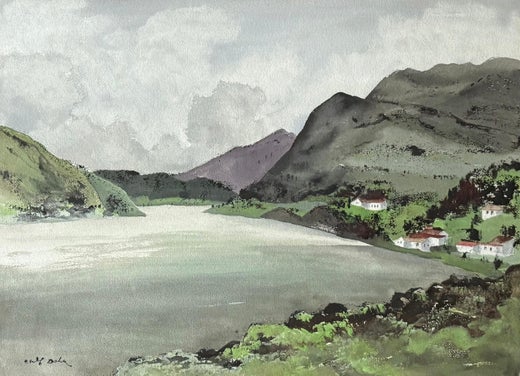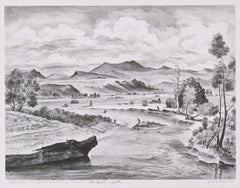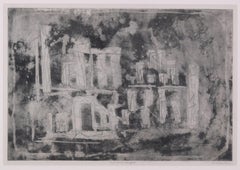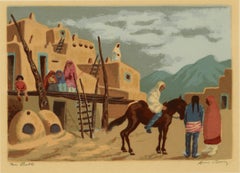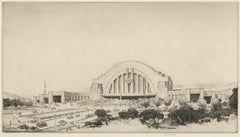Want more images or videos?
Request additional images or videos from the seller
1 of 11
Adolf Arthur DehnBrooklyn Waterfront1930
1930
$9,500List Price
About the Item
- Creator:Adolf Arthur Dehn (1895-1968, American)
- Creation Year:1930
- Dimensions:Height: 13.13 in (33.36 cm)Width: 19.13 in (48.6 cm)
- Medium:
- Movement & Style:
- Period:
- Condition:Lithograph on laid gray paper, watermarked "Roma" and "Made in Italy".
- Gallery Location:Fairlawn, OH
- Reference Number:Seller: AD01152.AP21stDibs: LU14015959642
Adolf Arthur Dehn
Adolf Dehn, printmaker, watercolorist, and illustrator, was born in Waterville, Minnesota, in 1895. In 1914 he began studying at the Minneapolis School of Art, and in 1917, the year his first published drawing appeared in the progressive magazine, The Masses, he received a scholarship to study at the Art Students League in New York. There he worked with Kenneth Hayes Miller and was introduced to lithography by Boardman Robinson. While in New York, Dehn threw himself into liberal politics. Declaring himself a conscientious objector in 1918, he was forced to spend four months in a Spartanburg, South Carolina, boot camp for refusing to serve in the armed forces and eight months as a volunteer instructor teaching painting and drawing at a hospital for war victims in Asheville, North Carolina. Dehn spent the years 1920 to 1929 in art-related travel in Europe, primarily in Vienna and in Paris, where he made lithographs at the Atelier Desjobert. Throughout this time, Dehn exhibited his work at the Weyhe Gallery in New York and contributed drawings both to magazines abroad and to the radical journal The Masses. Upon his return to New York in 1929, he became a leading figure in printmaking circles, exhibiting his prints to considerable critical acclaim. In 1937, Dehn had worked exclusively in black and white until 1937—halfway through his career—when he began to work in watercolor. During his summer visits to Minnesota, he created a large body of regional watercolors depicting the lakes and farms of his home state. Lithography and watercolor remained his two primary media, and his subjects ranged from social satire to naturalistic landscapes. He authored the treatise, Water Color Painting, in 1945 and two other instructional books on lithography and watercolor in 1950 and 1955. From 1938 to 1939 he taught at Stephens College in Columbia, Missouri, and during the summers of 1940-1942 he taught at the Colorado Springs Fine Arts Center. In 1939 and 1951 Dehn received Guggenheim Fellowships, and 1961 he was elected Full Academician to the National Academy of Design. Dehn exhibited throughout his career, and his works are in the permanent collections of the Metropolitan Museum of Art, the Museum of Modern Art, the Art Institute of Chicago, the Museum of Fine Arts in Boston, and the British Museum, among others. Adolf Dehn died in New York in 1968.
About the Seller
5.0
Recognized Seller
These prestigious sellers are industry leaders and represent the highest echelon for item quality and design.
Gold Seller
Premium sellers maintaining a 4.3+ rating and 24-hour response times
Established in 1978
1stDibs seller since 2013
833 sales on 1stDibs
Associations
International Fine Print Dealers Association
Authenticity Guarantee
In the unlikely event there’s an issue with an item’s authenticity, contact us within 1 year for a full refund. DetailsMoney-Back Guarantee
If your item is not as described, is damaged in transit, or does not arrive, contact us within 7 days for a full refund. Details24-Hour Cancellation
You have a 24-hour grace period in which to reconsider your purchase, with no questions asked.Vetted Professional Sellers
Our world-class sellers must adhere to strict standards for service and quality, maintaining the integrity of our listings.Price-Match Guarantee
If you find that a seller listed the same item for a lower price elsewhere, we’ll match it.Trusted Global Delivery
Our best-in-class carrier network provides specialized shipping options worldwide, including custom delivery.You May Also Like
Original 1959 Les Fetes de Provence Annee Mireille, French vintage poster
By Yves Brayer
Located in Spokane, WA
Original 1959 Yves Brayer Poster — Les Fêtes de Provence (Année Mireille). Archival linen-backed, original French vintage poster — ready to frame.
• Authentic 1959 French travel/cu...
Category
1950s American Modern Portrait Prints
Materials
Lithograph
$525
H 23 in W 16 in D 0.3 in
Cat and Busybody
By Benton Murdoch Spruance
Located in Middletown, NY
A 1933 lithograph on cream wove paper 14 x 18 inches (354 x 452mm), full margins. Signed, titled, and numbered 17/33 in pencil, lower margin. Minor mat tone around the perimeter of t...
Category
1930s American Modern Landscape Prints
Materials
Lithograph
Private Property (Jamaica Bay in Queens NY - now a runaway of JFK airport)
By Martin Levine
Located in New Orleans, LA
Private Property was created in 1982 and is #25 from an edition of 40.
Martin Levine (born 14 May 1945 in New York City) is an American artist.
Levine...
Category
1980s American Modern Landscape Prints
Materials
Lithograph
$262 Sale Price
41% Off
H 28 in W 22.5 in
Arnold Ronnebeck Lithograph of Gregory Point, Colorado, 1930s Modernist Print
By Arnold Rönnebeck
Located in Denver, CO
This original 1930s lithograph by renowned modernist artist Arnold Ronnebeck (1885–1947) captures a historic home at Gregory Point, near Central City, Colorado. Part of a limited edi...
Category
1930s American Modern Landscape Prints
Materials
Paper, Lithograph
$2,650
H 23.25 in W 18.5 in D 1.5 in
Original "Queen of the Jungle" US 1-sheet vintage (1935) movie poster
Located in Spokane, WA
Original Queen of the Jungle vintage lithograph movie poster, archival linen backed. US 1-sheet.
"The Temple of Mu." Serial. Episode No 10. St...
Category
1930s American Modern Animal Prints
Materials
Lithograph
$760 Sale Price
20% Off
H 41 in W 27.5 in D 0.05 in
Original 'We're both needed to serve the Guns!" vintage British poster, 1915
Located in Spokane, WA
Original poster: FILL UP THE RANKS PILE UP THE MUNITIONS!
Artist: F. Gardner. Year: 1915. Horizontal original British WW1 poster. Very good cond...
Category
1910s American Modern Landscape Prints
Materials
Lithograph
$780 Sale Price
20% Off
H 20 in W 29 in D 0.05 in
Original "Back Them Up!" vintage British WWII poster
Located in Spokane, WA
Original WWII poster: A British "Commando" raid on a German-held port in Norway. Back Them Up! Linen backed and ready to frame. Printed in England...
Category
1940s American Modern Landscape Prints
Materials
Lithograph
$1,480 Sale Price
20% Off
H 29 in W 19.35 in D 0.05 in
Signed George Elbert Burr Winter Landscape Lithograph, Snow-Covered Trees
By George Elbert Burr
Located in Denver, CO
This original signed lithograph by acclaimed American artist George Elbert Burr (1859–1939) beautifully depicts a serene winter landscape with snow-covered trees. Burr’s masterful lithograph technique captures the delicate interplay of light, shadow, and snow, evoking the quiet stillness and crisp beauty of nature in winter.
The image measures 7 ¼ by 10 ¼ inches and is presented in a custom archival frame with overall dimensions of 15 x 17 ¾ inches. The artist’s signature authenticates this fine example of early 20th-century American printmaking, making it an ideal addition to collections of Western art, winter landscapes, or vintage lithographs.
Born in Ohio, Burr was largely self-taught, gaining recognition for his detailed etchings and lithographs that captured the American West’s rugged beauty. After years of travel across Europe and the U.S. Southwest, he created iconic series like Mountain Moods and the Desert Set...
Category
20th Century American Modern Landscape Prints
Materials
Lithograph
$1,650
H 15 in W 17.75 in D 0.75 in
La Casa Vivienda
By Emilio Sanchez
Located in New York, NY
“LA CASA VIVENDA”
Emilio Sanchez (1921-1999) created this color lithograph entitled “La Casa Vivenda” circa 1991. Image size 18.38 x 25 inches and the paper size 21.75 x 29.38 inches. Printed in an edition of 100 this impression is inscribed “70/100” - the 70th impression of 100. This impression is pencil signed in the lower right and inscribed in the lower left.
“Best known for his architectural paintings and lithographs, Emilio Sanchez (1921-1999) explored the effects of light and shadow to emphasize the abstract geometry of his subjects. His artwork encompasses his Cuban heritage...
Category
1990s American Modern Landscape Prints
Materials
Lithograph
Original 'Gone with the Wind" vintage German movie poster
Located in Spokane, WA
Original Gone with the Wind “Vom Winde Verweht” vintage lithograph poster.
Original vintage movie poster with professional acid-free linen backing; excellent condition; ready to frame. This is the German 1962 release of Gone with the Wind, printed in the full lithographic style of the old French posters. Unique imagery of the famous scene of the burning of Atlanta.
Starring Clark Gable, Vivien Leigh, Leslie Howard, Olivia de Havilland...
Category
1860s American Modern Portrait Prints
Materials
Lithograph
$628 Sale Price
20% Off
H 33 in W 23.75 in D 0.05 in
More From This Seller
View AllTrout Fishing on the Gunnison (Colorado)
By Adolf Dehn
Located in Fairlawn, OH
Trout Fishing on the Gunnison (Colorado)
Lithograph, 1941
Signed and dated '42 in pencil lower right
Annotated lower left:
"40 Prints-The Gunnison River, Colorado-For Anne & Jack"
Ed...
Category
1940s American Modern Landscape Prints
Materials
Lithograph
Ancient Landscape II (Ancient City)
By Louise Nevelson
Located in Fairlawn, OH
Ancient Landscape II (Ancient City)
Etching and drypoint, 1953-55
Signed and titled in pencil by the artist (see photos)
Annotated: "E130 A/1" in pencil lower right
Estate stamp vers...
Category
1950s American Modern Landscape Prints
Materials
Drypoint
Taos Pueblo
By Anna Barry
Located in Fairlawn, OH
Taos Pueblo
Screen print in colors, c. 1945
Signed and titled in pencil by the artist
Printed in Taos
Taos is the oldest continually inhabited city/village in North America.
How old ...
Category
1940s American Modern Landscape Prints
Materials
Screen
Cincinnati Union Terminal, Perspective From East
By Louis Conrad Rosenberg
Located in Fairlawn, OH
Cincinnati Union Terminal, Perspective From East
Drypoint, 1930-1931
Signed in pencil lower right (see photo)
Initialed and dated the the plate above the pencil signature
From: Cincinnati Series (8 Plates), this No. 2
Edition: 155, completed May 4, 1931
Delivered to Fellheimer & Wagner, 1931
Louis Conrad Rosenberg
1890-1983
An American architectural etcher and engraver of the 1920's and 1930's era, Louis Conrad Rosenberg first studied at the Massachusetts Institute of Technology...
Category
1930s American Modern Landscape Prints
Materials
Drypoint
River Reflections
By Arthur Wesley Dow
Located in Fairlawn, OH
River Reflections
Color woodcut, c. 1910
Unsigned
Provenance: Dow Family Album, Cincinnati
Condition: Excellent
Image size: 2 1/2 x 4 inches
Sheet size: 3 1/8 x 4 7/8”
A color varian...
Category
1910s American Modern Landscape Prints
Materials
Woodcut
East River View of N.Y.
By Mark Freeman
Located in Fairlawn, OH
East River View of N.Y.
Etching, 1934
Signed, dated and titled in pencil by the artist
From a very small edition.
Brilliant impression
Condition: Excellent
Image/Plate size: 5-1/8 x...
Category
1930s American Modern Landscape Prints
Materials
Etching
Still Thinking About These?
All Recently ViewedMore Ways To Browse
Lawrence Heyman
Lawrence Josset
Leroy Neiman Serigraphs Sailing
Lilian May Miller
Lionel Lindsay
Maine Woodcut
Mammoth Ski Poster
Marco Sadeler
Mary Teichman
Monet Etching
Orchard By David Harrison
Oscar De Mejo
Pablo Picasso Original Inc Sketch
Paul Baum
Paul Emile Lecomte Etching
Paul Pedulla
Peter De Pannemaeker
Peter Max Boat
